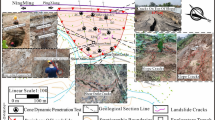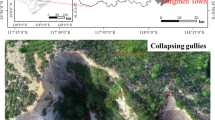Abstract
Soil cracking is an important process influencing water and solutes transport in the Yuanmou Dry-hot Valley region of Southwest China. Studying the morphological development of soil cracks helps to further reveal the close relationship between the soil cracking process and water movement in such semi-arid regions. Here we report regular changes on surface morphology of soil cracks with decreasing water in four different soils (Typ-Ustic Ferrisols, Ver-Ustic Ferrisols, Tru-Ustic Vertisols and Typ-Ustic Vertisols) through simulation experiments. Our results indicate the following: 1) Different soils ultimately have different development degrees of soil cracks, according to their various values of crack area density. Soil cracks in Typ-Ustic Ferrisols can only develop to the feeble degree, while those in the other three soils are capable of developing into the intensive degree, and even into the extremely intensive degree. 2) Soil crack complexity, as expressed by the value of the area-weighted mean of crack fractal dimension (AWMFRAC), is found to continuously decrease as a whole through the whole cracking process in all the studied soils. 3) Soil crack connectivity shows a uniform trend in the studied soils, that is to say, connectivity gradually increases with soil crack development.
Similar content being viewed by others
References
Adams J, Hanks R, 1964. Evaporation from soil shrinkage cracks. Soil Science Society of America Proceedings, 28: 281–284.
Adrian A, Karin A, Nadia A et al., 2000. Comparison of the performance of pesticide-leaching models on a cracking clay soil: Results using the Brimstone Farm dataset. Agricultural Water Management, 44(1–3): 85–104. DOI: 10.1016/S0378-3774(99)-00086-4
Bandyopadbyay K, Mohanty P, Misra A, 2003. Influence of tillage practices and nutrient management on crack parameters in a vertisol of Central India. Soil & Tillage Research, 71(2): 133–142. DOI: 10.1016/S0167-1987(03)00043-6
Bruand A, Cochrane H, Fisher P, 2001. Increase in the bulk density of a grey clay subsoil by infilling of cracks by topsoil. European Journal of Soil Science, 52(1): 37–47. DOI: 10.1046/j.1365-2389.2001.t01-1-00365.x
Chen Yu, Chen Ling, 1998. Fractal Geometry. Beijing: Earthquake Press. (in Chinese)
Flowers M, Lal R, 1999. Axle load and tillage effects on the shrinkage characteristics of a Mollic Ochraqualf in northwest Ohil. Soil & Tillage Research, 50(3–4): 251–258. DOI: 10.101-016/S0167-1987(99)00009-4
He Yurong, Xu Jianzhong, Huang Chenmin, 1995. Characteristics and soil taxonomy of Vertisol in Jinsha Dry-hot Valley. Acta Pedologica Sinica, 32(Supp.): 102–110. (in Chinese).
He Yurong, Huang Chenmin, 1995. Soil taxonomy for Yuanmou Dry-hot Valley. Mountain Research, 13(2): 73–78. (in Chinese)
Hendriks Rob F A, Oostindie Klaas, Hamminga Pim, 1999. Simulation of bromide tracer and nitrogen transport in a cracked clay soil with the FLOCR/ANIMO model combination. Journal of Hydrology, 215(1–4): 94–115. DOI: 10.1016/S0022-1694(98) 00264-9
Huang Chenmin, He Yurong, 1995. Soil basic physical properties in Yuanmou Dry-hot Valley Region. Bulletin of Soil Agricultural Chemistry, 10(1): 23–28. (in Chinese)
Huang Shuhui, Hari K Pant, Lu Jun, 2008. Nitrous oxide emissions in nonflooding period from fallow paddy fields. Journal of Environment Sciences, 20(11): 1335–1340. DOI: 10.1016/S-1001-07424(08)62230-5
Hulugalle N R, Cooper J, 1994. Effect of crop rotation and residue management on properties of cracking clay soil under irrigated cotton-based farming systems of New South Wales. Land Degradation & Rehabilitation, 5(1): 1–11.DOI: 10.1002/ldr.34-00050102
Institute of Soil Science, Chinese Academy of Sciences, 1978. Analysis of Soil Physic-chemical Property. Shanghai: Shanghai Science and Technology Press. (in Chinese)
Liu Chenwu, Cheng Shiwei, Yu Wensheng et al., 2003. Water infiltration rate in cracked paddy soil. Geoderma, 117(1–2): 169–181. DOI: 10.1016/S0016-7061(03)00165-4
Mattews A M, Portwood A M, Armstrong A C et al., 2000. CRACK-NP, development of a model for predicting pollutant transport in cracking clay soils. Soil Use and Management, 16(4): 279–284. DOI: 10.1111/j.1475-2743.2000.tb00210.x
Novak V, 1999. Soil-crack characteristics-Estimation methods applied to heavy soils in the NOPEX area. Agricultural and Forest Meteorology, 98: 501–507. DOI: 10.1016/S0168-1923 (99)00119-7
Novak V, Simunek J, van Genuchten M Th, 2000. Infiltration of water into soil with cracks. Journal of Irrigation and Drainage, Engineering, 126: 41–47.
Rayhani M H T, Yanful E K, Fakher A, 2007. Desiccation induced cracking and its effect on hydraulic conductivity of clayey soils from Iran. Canadian Geotechnical Journal, 44(3): 276–283.
Romkens M J M, Prasad S N, 2006. Rain infiltration into swelling/shrinking/cracking soils. Agricultural Water Management, 86(1–2): 196–205. DOI: 10.1016/j.agwat.2006.07.012
Velde B, 1999. Structure of surface cracks in soil and mud. Geoderma, 93(1–2): 101–124. DOI: 10.1016/S0016-7061(99)00-047-6
Vogel H, Hoffmann H, Roth K, 2005. Studies of crack dynamics in clay soil experimental methods, results, and morphological quantification. Geoderma, 125(3–4): 203–211. DOI: 10.1016/j. geoderma.2004.07.009
Xiong Donghong, Zhou Hongyi, Du Changjiang et al., 2006. A review on soil crack study. Soil, 38(3): 249–255. (in Chinese)
Xiong Donghong, Zhou Hongyi, Yang Zhong et al., 2005. Slope lithologic property, soil moisture condition and re-vegetation in Dry-hot Valley of Jinsha River. Chinese Geographical Science, 15(2): 186–192. DOI: 10.1007/s11769-005-0014-x
Xiong Donghong, Lu Xiaoning, Xian Jishen et al., 2008. Selection of judging indicators for surface morphology of soil crack under different development degrees in Yuanmou Arid-hot Valley Region. Wuhan University Journal of Natural Sceinces, 13(3): 363–368. DOI: 10.1007/s11859-008-0317-8
Xiong Donghong, 2008. Soil Crack’s Morphological Feature and It’s Development Law in Yuanmou Dry-hot Valley Region. Beijing: Graduate University of the Chinese Academy of Sciences. (in Chinese)
Xiong Donghong, Long Yi, Yan Dongchun et al., 2009. Surface morphology of soil cracks in Yuanmou Dry-hot Valley Region, Southwest China. Journal of Mountain Science, 6(4): 373–379. DOI: 10.1007/s11629-009-1059-6
Xu Jianhua, 2002. Mathematic Methods in Contemporary Geography. Beijing: Higher Education Press. (in Chinese)
Yang Zhong, Xiong Donghong, Zhou Hongyi et al., 2003. Rainfall infiltration on hilly slopes under various lithology and its effect on tree growth in the Dry-hot Valley. Science in China (Ser. E), 33(Supp.): 85–93.
Yao Xianliang, Cheng Yunsheng, 1983. Soil Physics. Beijing: Agriculture Press. (in Chinese)
Yoshida S, Adachi K, 2004. Numerical analysis of crack generation in saturated deformable soil under row-planted vegetation. Geoderma, 120(1–2): 63–74. DOI: 10.1016/j.geoderma.2003.08.009
Zhang Xinbao, Yang Zhong, Zhang Jianping, 2003. Lithologic types on hill slopes and re-vegetation zoning in the Yuanmou Hot and Dry Valley. Scientia Silvae Sinicae, 39(4): 16–22. (in Chinese)
Author information
Authors and Affiliations
Corresponding author
Additional information
Foundation item: Under the auspices of National Natural Science Foundation of China (No. 40901009), National Key Technologies Research and Development Program in the Eleventh Five-Year Plan of China (No. 2008BAD98B02, 2006BAC01A11), the Western Light Program of Talents Cultivating of Chinese Academy of Sciences (2008), the Foundation of Key Laboratory of Mountain Hazards and Surface Process, Chinese Academy of Sciences
Rights and permissions
About this article
Cite this article
Xiong, D., Yan, D., Long, Y. et al. Simulation of morphological development of soil cracks in Yuanmou Dry-hot Valley region, Southwest China. Chin. Geogr. Sci. 20, 112–122 (2010). https://doi.org/10.1007/s11769-010-0112-2
Received:
Accepted:
Published:
Issue Date:
DOI: https://doi.org/10.1007/s11769-010-0112-2




